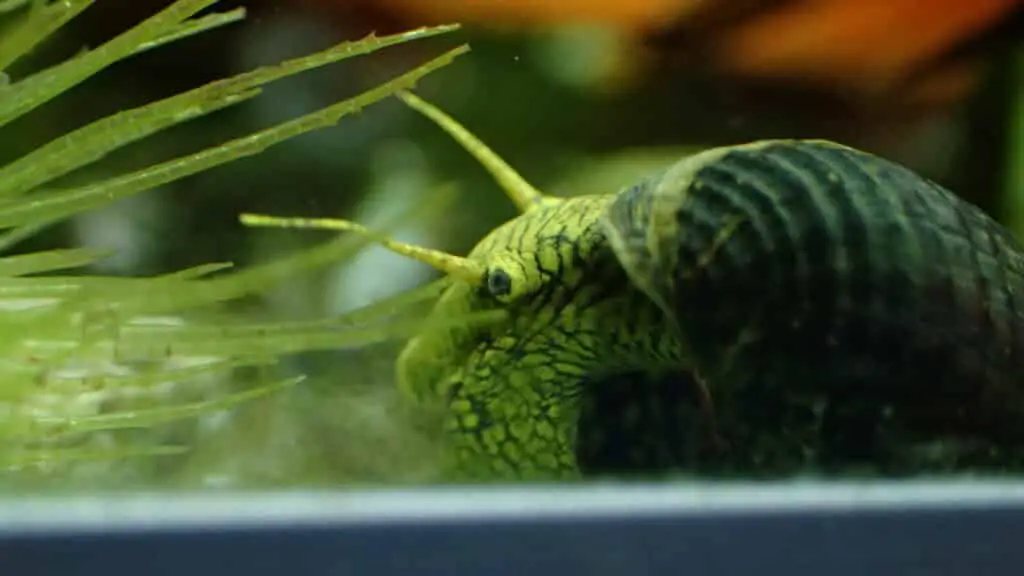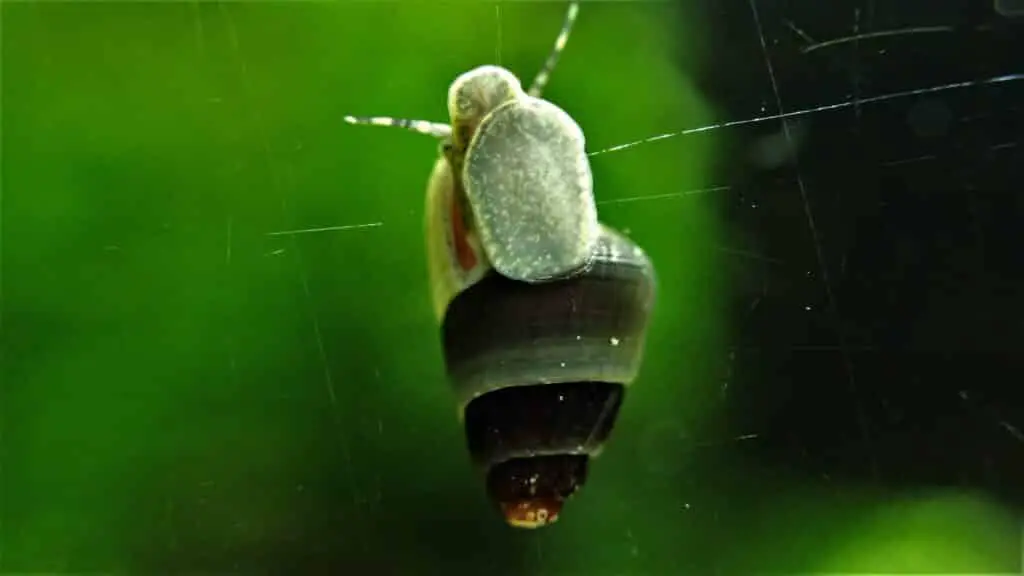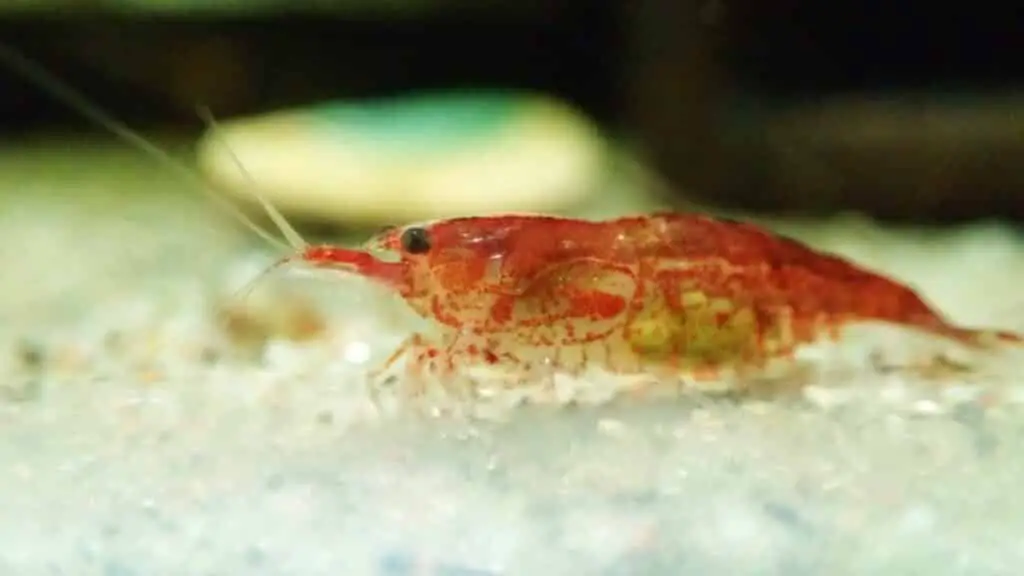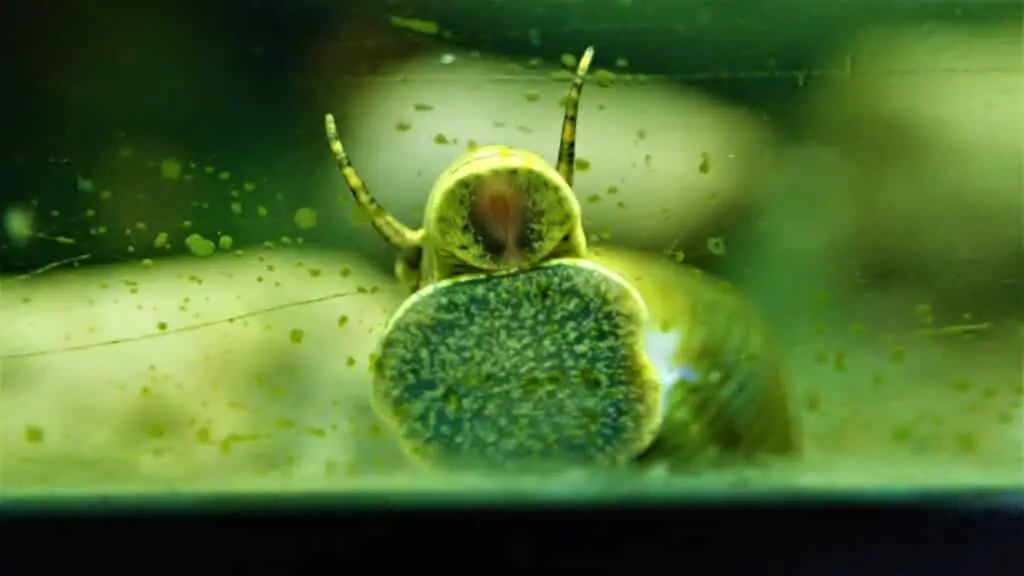How to Breed Rabbit Snails? Breeding rabbit snails can be simple and rewarding. First, set up an appropriate aquatic environment with clean water, plants, and hiding spots. Provide calcium-rich foods to promote shell growth. Then, ensure a suitable male-female ratio, and monitor closely for eggs, which hatch in 3-4 weeks.
Common names for rabbit snails:
- Rabbit Snail
- Elephant Snail
- Tylomelania
Detailed table of parameters for breeding rabbit snails
Here’s a table with the water parameters, adult size, and difficulty level for rabbit snails:
| Parameter | Ideal Range |
|---|---|
| Temperature | 75-84°F (24-29°C) |
| pH | 7.5-8.5 |
| Hardness (dGH) | 4-12 |
| Ammonia (NH3) | 0 ppm (near 0) |
| Nitrite (NO2) | 0 ppm (near 0) |
| Nitrate (NO3) | < 20 ppm |
| Rabbit Snails | Adult Size | Difficulty |
|---|---|---|
| Rabbit Snails | 2-4 inches | Easy |
Introduction to Rabbit Snails and Their Breeding
Rabbit snails, also known as Elephant Snails or Tylomelania, are a fascinating and unique species of freshwater snails, native to the ancient lakes of Sulawesi, Indonesia. They are known for their distinct appearance, featuring elongated, spiral shells that resemble rabbit ears, and an elephant-like trunk-like proboscis.
Rabbit snails are gaining popularity among aquarists for their interesting appearance, low bioload, and algae-eating habits, making them a desirable addition to many freshwater aquariums.
Breeding rabbit snails can be a rewarding experience for hobbyists, as their reproductive process is unique among freshwater snails. Unlike many other snail species that lay large numbers of eggs at once, rabbit snails reproduce more slowly and lay single, sizeable eggs.
The eggs are enclosed in a gelatinous, amber-colored casing, which is often deposited on aquarium surfaces or among plants. After a gestation period of around 3-4 weeks, the eggs will hatch into fully formed juvenile snails, ready to explore their new environment.
Successful breeding of rabbit snails requires attention to several key factors. The first is providing a suitable aquatic environment that meets their specific needs. A well-maintained tank with clean, stable water parameters, ample hiding spots, and live plants will promote rabbit snail health and breeding behaviors.
Additionally, a proper diet rich in calcium is crucial for shell growth and overall health, as this supports reproduction.

Setting Up the Ideal Rabbit Snail Habitat
Creating the perfect environment for rabbit snails is essential for their health, well-being, and successful breeding. Paying attention to specific requirements like tank size, water parameters, and habitat setup will help ensure a thriving rabbit snail community. Here’s a step-by-step guide to setting up the ideal rabbit snail habitat:
- Tank size: Rabbit snails need ample space to move and explore. A tank of at least 10 gallons is recommended, but larger tanks are preferable, especially if you plan to house multiple snails or other tank inhabitants.
- Substrate: A sandy or fine-grained gravel substrate is ideal for rabbit snails, as it allows them to burrow and search for food. Avoid sharp-edged substrates that can damage their soft bodies.
- Filtration: A high-quality filter is essential for maintaining clean, stable water conditions. Choose a filter that can handle the bioload of your tank, and make sure the water flow is gentle enough not to stress the snails.
- Water parameters: Rabbit snails thrive in water with a temperature between 75-84°F (24-29°C), a pH level of 7.5-8.5, and a hardness of 4-12 dGH. Regularly monitor and adjust these parameters to maintain a stable environment.
- Live plants: Incorporate live plants into your rabbit snail habitat, as they help maintain water quality, provide hiding spots, and serve as a food source. Java fern, Anubias, and mosses are suitable options that can withstand rabbit snail grazing.
- Hiding spots: Rabbit snails appreciate hiding spots, which can be created using driftwood, rocks, or commercially available hideouts. Providing multiple hiding spots promotes a sense of security and encourages breeding behavior.
- Lighting: Maintain a natural day-night cycle with moderate lighting to replicate rabbit snails’ natural habitat. Too much light can lead to excessive algae growth, while too little can hinder plant growth.
- Tankmates: If you plan to house your rabbit snails with other aquatic species, choose peaceful, non-aggressive tankmates.
- Diet: Supplement their diet with calcium-rich foods, like cuttlebone, calcium-enriched snail pellets, and blanched vegetables, to promote healthy shell growth and improve breeding success.
- Maintenance: Regular water changes, tank cleaning, and monitoring of water parameters are crucial to maintaining a healthy rabbit snail habitat.

Understanding Rabbit Snail Sexing and Mating
Rabbit snails, unlike some other snail species, are gonochoristic, meaning they have distinct male and female individuals. This unique aspect of their reproductive biology makes it important for hobbyists to understand rabbit snail sexing and mating in order to promote successful breeding.
Sexing Rabbit Snails:
Sexing rabbit snails can be challenging, as external differences between males and females are subtle and often difficult to observe. However, there are a few signs that may help distinguish their sexes:
- Shell Shape: Some aquarists suggest that female rabbit snails tend to have slightly larger and rounder shells compared to males. This difference may be more evident in mature individuals.
- Body Coloration: In certain rabbit snail species, females may exhibit slightly more vivid body coloration than males, although this is not a foolproof method for sexing.
- Behavior: Observing the behavior of rabbit snails can sometimes provide clues to their sex. Males are often seen as more active, especially during mating periods, as they actively search for females to mate with.
Despite these potential indicators, it is not always possible to accurately sex rabbit snails. As a result, maintaining a group with an adequate male-to-female ratio (1:2-3) is advised to increase the likelihood of successful mating.
Mating Behavior:
Once a male rabbit snail locates a receptive female, the mating process begins. Mating can last for several hours and involves the male mounting the female to transfer sperm. After successful mating, the fertilized female will lay her eggs one by one in a gelatinous, amber-colored casing. These egg casings are often deposited on aquarium surfaces, decorations, or among plants.
Rabbit snails reproduce more slowly than many other freshwater snail species, typically laying only one egg at a time. The gestation period for rabbit snail eggs is approximately 3-4 weeks, after which the eggs hatch into fully formed juvenile snails.

Providing Proper Nutrition for Breeding Rabbit Snails
A well-balanced diet is essential for the overall health of rabbit snails and plays a crucial role in their breeding success. Rabbit snails are primarily herbivores and detritivores, feeding on algae, decaying plant matter, and biofilm.
Providing proper nutrition for breeding rabbit snails involves offering a variety of calcium-rich foods and supplements to promote healthy shell growth and reproductive fitness. Here are some tips for ensuring that your rabbit snails receive the nutrients they need:
- Algae and Biofilm: Rabbit snails will naturally graze on algae and biofilm present in the aquarium. Allowing some algae growth on surfaces, like rocks and decorations, can provide a natural food source for your snails.
- Vegetables: Blanched vegetables, such as zucchini, spinach, kale, and lettuce, are excellent sources of nutrients for rabbit snails. Be sure to remove any uneaten vegetables after 24 hours to prevent water quality issues.
- Commercial Snail Foods: Specially formulated snail pellets or wafers are available on the market and can be an excellent addition to your rabbit snails’ diet. These foods typically contain essential nutrients, including calcium, to support shell growth and overall health.
- Calcium Supplements: Calcium is crucial for rabbit snails to maintain strong, healthy shells and to support successful breeding. Supplement their diet with cuttlebone or crushed eggshells, which can be placed directly in the tank for the snails to graze on. Alternatively, consider adding a calcium-rich liquid supplement to the water.
- Feeding Schedule: Rabbit snails should be fed 2-3 times per week, adjusting the frequency based on their consumption rate. Remove any uneaten food after a day to maintain water quality.
- Monitor Growth: Keep an eye on your rabbit snails’ shell health and overall appearance. If their shells appear to be thinning or cracking, it may indicate a lack of calcium or other essential nutrients.
In the natural habitats of snails, both aquatic and terrestrial, these creatures are accustomed to consuming large amounts of nutrient-deficient plant matter. This dietary pattern enables them to extract the necessary nutrients by consuming a higher volume of food. It’s essential to understand this aspect of their feeding behavior in order to provide the appropriate care and diet for your snails.
Land snails, for instance, might consume a significant amount of lettuce, which is low in nutrients but high in fiber. While lettuce may not be the most nutrient-dense food source, land snails compensate for this by eating large quantities of it to fulfill their nutritional needs. Offering a diverse diet, which includes other leafy greens and vegetables, can further enhance the nutritional intake of land snails.
Aquarium snails share similar feeding habits, as they too rely on consuming substantial amounts of low-nutrient plant matter. In the wild, they often graze on biofilm and algae that grow on surfaces, which provide them with essential nutrients, albeit in limited amounts. Therefore, it’s crucial to provide aquarium snails with a well-balanced diet that mimics their natural eating behavior.
To replicate their natural feeding habits, offer a variety of vegetables, such as spinach, kale, and zucchini, cucumber alongside the algae and biofilm present in the tank. Including commercially available snail pellets or wafers can further supplement their diet, as these products are often formulated with essential nutrients that support shell growth and overall health.

Monitoring Rabbit Snail Egg Laying and Hatching
Observing the egg-laying and hatching process of rabbit snails is a fascinating aspect of their breeding cycle. Unlike many other freshwater snails that lay numerous eggs in a single mass, rabbit snails lay individual eggs encased in gelatinous, amber-colored casings.
Monitoring this process closely will allow you to better understand their reproductive behavior and ensure that the juveniles have the best chance of survival. Here are some key aspects of rabbit snail egg-laying and hatching:
- Identifying Egg Casings: Rabbit snail eggs are typically deposited on aquarium surfaces, decorations, or among plants. The casings are gelatinous and amber-colored, making them relatively easy to spot. Regularly inspect your aquarium for these casings to monitor your rabbit snails’ reproductive activity.
- Gestation Period: The gestation period for rabbit snail eggs is approximately 3-4 weeks. During this time, it is essential to maintain stable water parameters and optimal environmental conditions to support the successful development of the embryos.
- Protecting the Eggs: Ensure that the rabbit snail eggs are protected from potential predators, including fish or other invertebrates that might consume the eggs. If necessary, consider isolating the eggs in a separate breeding tank or using a mesh breeder box to safeguard them from predation.
- Hatching Process: Rabbit snail eggs will hatch into fully formed juvenile snails, which are miniature replicas of their adult counterparts. The newly hatched snails will immediately begin exploring their environment and searching for food. Observe the juveniles closely to ensure they are active and healthy.
- Caring for Juveniles: Provide the young rabbit snails with a calcium-rich diet, similar to that of the adults, to support healthy shell growth. The juveniles may be more susceptible to changes in water parameters, so it is crucial to maintain a stable and clean environment during their early stages of development.
- Growth Rate: Rabbit snails have a relatively slow growth rate, taking several months to reach adulthood. Monitor their growth and shell health regularly, adjusting their diet and care as needed.
- Introducing Juveniles to the Main Tank: Once the juvenile rabbit snails have grown large enough, they can be carefully introduced to the main aquarium, provided that the tank conditions are suitable and there are no potential predators.
Monitoring the egg-laying and hatching process of rabbit snails is a rewarding aspect of breeding these unique creatures. By providing optimal conditions and closely observing their reproductive behavior, you can help ensure the survival and success of future generations of rabbit snails in your aquarium.

Tips for Maintaining Optimal Water Quality
Maintaining optimal water quality is essential for the health and well-being of your rabbit snails and any other aquatic species in your aquarium. Proper water quality ensures a stable environment that promotes natural behaviors, growth, and successful breeding. Here are some tips for maintaining optimal water quality in your rabbit snail habitat:
- Regular Water Changes: Conducting regular water changes is one of the most effective ways to maintain water quality. Replace 20-30% of the tank water with fresh, dechlorinated water every 1-2 weeks. This will help dilute harmful substances, remove excess nutrients, and maintain stable water parameters.
- Effective Filtration: Invest in a high-quality filter that can handle the bioload of your tank. Ensure that the filter media is cleaned or replaced according to the manufacturer’s recommendations to maintain its efficiency. Additionally, consider using a sponge pre-filter to protect the snails from being sucked into the filter intake.
- Monitor Water Parameters: Regularly test the water parameters, including temperature, pH, hardness, ammonia, nitrite, and nitrate levels. Rabbit snails thrive in water with a temperature between 75-84°F (24-29°C), a pH level of 7.5-8.5, and a hardness of 4-12 dGH. Use aquarium test kits to monitor these parameters and make any necessary adjustments.
- Cycle the Tank: Before introducing rabbit snails or any other aquatic species to a new aquarium, ensure that the tank has been properly cycled. Cycling allows the establishment of beneficial bacteria that convert harmful ammonia and nitrite into less toxic nitrate, creating a stable and healthy environment.
- Live Plants: Incorporate live plants into your aquarium, as they help improve water quality by absorbing excess nutrients, providing oxygen, and stabilizing the nitrogen cycle. Choose hardy plants that can withstand rabbit snail grazing, such as Java fern, Anubias, or various moss species.
- Remove Uneaten Food and Debris: Regularly remove any uneaten food, dead plants, or other debris from the tank to prevent the buildup of harmful substances and maintain water quality.
- Control Algae Growth: Excessive algae growth can be an indicator of poor water quality. Keep algae under control by maintaining a proper balance of light and nutrients, and manually removing algae when necessary.
- Avoid Overstocking: Overstocking your aquarium can lead to poor water quality and stress on the inhabitants. Ensure that your tank has adequate space and filtration capacity for the number of rabbit snails and other species you plan to keep.
- Quarantine New Additions: Quarantine any new aquatic species before introducing them to the main tank to prevent the introduction of diseases or parasites that could negatively impact water quality and the health of your rabbit snails.

Suitable Shrimp Tank Mates for Rabbit Snails
Rabbit snails are peaceful, non-aggressive creatures that can coexist well with various shrimp species. When selecting shrimp tank mates for your rabbit snails, it’s essential to consider the compatibility of their water parameters and environmental requirements. Here are some suitable shrimp tank mates for rabbit snails:
- Neocaridina Shrimp:
Neocaridina shrimp, such as Cherry Shrimp (Neocaridina davidi), are among the most popular shrimp species in the aquarium hobby due to their hardiness, bright colors, and adaptability. They are compatible with rabbit snails, as both species thrive in similar water parameters and have a peaceful disposition. Other Neocaridina species, including Blue Dream, Yellow, and Snowball shrimp, are also suitable tank mates for rabbit snails. I have Rabbit snails in all my neo tanks.
- Amano Shrimp:
Amano shrimp (Caridina multidentata) are a popular choice for planted aquariums due to their algae-eating abilities. They can be housed with rabbit snails, as they have a peaceful temperament and share similar water requirements.
- Ghost Shrimp:
Ghost shrimp (Palaemonetes paludosus) are a hardy, transparent shrimp species that can adapt to a wide range of water parameters. Their non-aggressive nature makes them suitable tank mates for rabbit snails.
- Sulawesi Shrimp:
Sulawesi shrimp, such as the Cardinal Shrimp (Caridina dennerli), are native to the same region as rabbit snails and can be housed together in a biotope aquarium. However, Sulawesi shrimp require stable water conditions and specific water parameters that may be challenging to maintain for beginners.
Other Sulawesi shrimp species, including Harlequin and White Orchid shrimp, can also be compatible with rabbit snails.
When setting up a community tank with rabbit snails and shrimp, it is crucial to ensure that the water parameters, temperature, and tank conditions are suitable for all inhabitants.

Drip Acclimating Rabbit Snails
Drip acclimation is an effective method for introducing rabbit snails to a new aquarium environment, as it gradually adjusts them to the water parameters and reduces the risk of stress. Just like shrimp, rabbit snails can benefit from this method, ensuring a smooth transition to their new home.
To perform drip acclimation for rabbit snails, follow these steps:
- Gather the necessary equipment, including a length of air tubing, a control valve, and an airstone.
- Place the rabbit snails in a clean, appropriately-sized container, such as a bucket or plastic tub.
- Attach one end of the air tubing to the airstone and the other end to the control valve.
- Start a siphon by submerging the airstone in the aquarium water and sucking on the opposite end of the air tubing. Quickly attach the tubing to the control valve once the siphon begins.
- Position the bucket or container with the snails lower than the aquarium to allow the siphon to work effectively.
- Adjust the control valve to achieve a drip rate of approximately 3 drips per second. The slow dripping ensures that the snails have enough time to gradually adjust to the new water parameters.
- Continue the drip acclimation process for about 1-2 hours, or until the water volume in the container has doubled. This will ensure that the snails have been adequately acclimated to the new water conditions.
- Once the acclimation process is complete, gently pick up each snail and place it into the aquarium. Do not drop them in, as rabbit snails have thick, heavy shells that can break if they fall on a hard surface.
Conclusion
Breeding rabbit snails can be an enriching and rewarding experience for aquarium enthusiasts. By understanding their unique reproductive biology, setting up the ideal habitat, providing proper nutrition, and maintaining optimal water quality, you can ensure the health and well-being of your rabbit snails throughout their breeding journey.
Remember to closely monitor their mating behavior, egg-laying, and hatching processes to support the successful growth and development of future generations. With patience, care, and attention to detail, you can enjoy the captivating world of rabbit snails and contribute to the flourishing population of these fascinating creatures in your aquarium.
FAQ Section: Rabbit Snails
- What are rabbit snails?
Rabbit snails, also known as Sulawesi snails or Tylomelania, are a genus of freshwater snails native to the Sulawesi region of Indonesia. They are popular in the aquarium hobby due to their unique appearance, slow movement, and peaceful nature.
- How big do rabbit snails get?
Adult rabbit snails can grow up to 2-4 inches (5-10 cm) in length, depending on the species. Their growth rate is relatively slow, taking several months to reach adulthood.
- How long do rabbit snails live?
Rabbit snails have a lifespan of around 2-3 years, although some individuals may live longer with optimal care and water conditions.
- What do rabbit snails eat?
Rabbit snails are primarily herbivores and detritivores. Their diet includes algae, biofilm, decaying plant matter, vegetables, and commercially available snail foods. Providing a calcium-rich diet is crucial for maintaining healthy shell growth.
- Can rabbit snails live with fish?
Rabbit snails can coexist with peaceful, non-aggressive fish species that will not prey on them. Avoid housing rabbit snails with large, aggressive fish, or species known to consume snails.
- Are rabbit snails good for aquariums?
Rabbit snails are beneficial to aquariums, as they help clean the tank by consuming algae, biofilm, and decaying plant matter. They are also non-aggressive and compatible with a variety of peaceful tankmates.
- Do rabbit snails reproduce quickly?
Rabbit snails have a relatively slow reproductive rate compared to many other freshwater snail species. They lay single eggs encased in gelatinous, amber-colored casings, and the gestation period is approximately 3-4 weeks.
- Can rabbit snails live in a community tank?
Yes, rabbit snails can live in a community tank with other peaceful, non-predatory aquatic species. Ensure that the water parameters, temperature, and tank conditions are suitable for all inhabitants to create a harmonious environment.
- How do I breed rabbit snails?
To breed rabbit snails, set up an ideal habitat with stable water parameters, provide a well-balanced diet, and maintain a suitable male-to-female ratio. Monitor their mating behavior, egg-laying, and hatching processes to support successful reproduction.
- What water parameters are best for rabbit snails?
Rabbit snails thrive in water with a temperature between 75-84°F (24-29°C), a pH level of 7.5-8.5, and a hardness of 4-12 dGH. Regularly test and adjust the water parameters to maintain a healthy environment for your snails.
